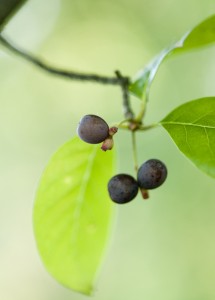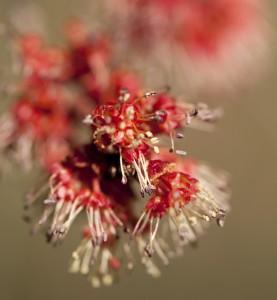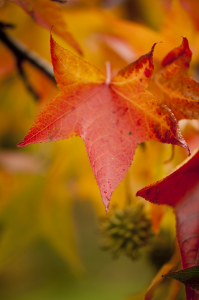Everyday Phenology
Posted in Horticulture on July 28 2014, by Jaime Morin
Jaime Morin is The New York Botanical Garden’s Assistant Curator in horticulture. She works with the plant records and curation teams to help keep the garden’s information on its living collections up to date. She also oversees the details of the garden’s Living Collections Phenology Project.

ripe fruit
Since its creation, the New York Botanical Garden has been a local haunt for scientists studying the phenology (the seasonally changing biological processes) of plants. More recently, the institution has invited the public to study these important seasonal markers as well through two citizen science programs.
In early 2001 the garden began a program that creates the opportunity for novice citizen scientists to collect data on the life cycle changes of plants in the Forest. Dedicated groups of volunteers traverse three different trails on a weekly basis, checking on 17 different kinds of forest plants to record their major seasonal benchmarks such as leaf emergence, flowering, and fruiting.
Starting in 2009, the Garden began to offer Citizen Science Professional Development for middle school teachers, focusing mostly on the native trees in the Forest. In turn, these teachers help their students conduct phenology research projects around their school at local parks, and on the Garden grounds. Over the years, with the support of the NYC Department of Education, the NYBG Professional Development Program has expanded its citizen offerings to K-12 teachers throughout the city.
This kind of data is critical to scientists studying the effects of climate change. The Forest Citizen Science Phenology program shares its information with more wide-spread programs such as the National Phenology Network, Northeast Regional Phenology Network, and Clean Air-Cool Planet, which distribute data to interested researchers. There is a big need for quality, long-term data that helps show how plants and animals may be reacting to the changing climate. Programs like this are a great way to fulfill that need.

early spring flowers
In early spring of 2012, a second phenology program was started, this time focusing on the living collections outside of the Forest. The aim of this project was to not only provide data to national scientists, but to gather information for NYBG visitors and staff regarding the peak bloom of its showiest plants and collections. The Living Collections Citizen Science Phenology project collects information on over 90 different kinds of plants across the Garden. Over half of the plants observed in the living collections phenology project contribute meaningful data to the National Phenology Network.
If you don’t volunteer with our formal programs here at the Garden, you can also contribute to this scientific endeavor on a national level in your own backyards or local neighborhoods. By logging on to the National Phenology Network’s Nature’s Notebook site and registering for an account, you can start collecting data on your own plants! Whether you enjoy keeping a keen eye out for birds and emerging foliage, or just want an excuse to spend a little bit more time outdoors, this is a great activity for hobbyist adventurers of all skill levels!

fall color
Looking for and tracking seasonal changes certainly has its benefits. It tends to sharpen observational skills. I know that while taking volunteers out for training I find myself trying to notice the smallest, most detailed changes in our plants here on the grounds. Tracking specific plants through years of their lives can also teach observers a great deal of botany, flowering morphology, and plant biology. Did you know that the gorgeous creamy white part of the dogwood “flower” is actually a bract rather than an actual reproductive floral structure? Did you know that Tulip trees form cone-like seed structures that shatter when ripe? These are just some of the things that studying a handful of specific species can teach you.
Whether you are part of a formalized program, or just an avid observer, taking notice of interesting seasonal changes can absolutely enrich your time outdoors.


How does one become a citizen scientist? I might be interested in doing this. I am currently a volunteer guide at the Garden.